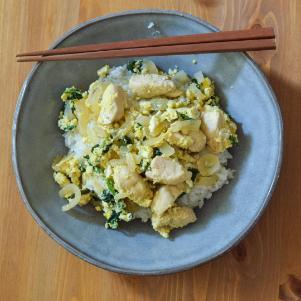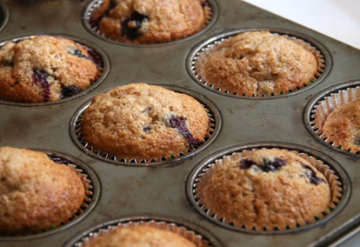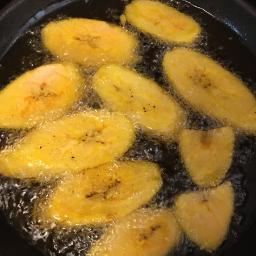IEW Digital Cookbook: Flavors Around the World
Food is a powerful connective tool. We build our bonds with friends and family over dinners, we go to restaurants on dates, we prepare food for others and with others. Even when we’re cooking and eating alone, food still connects us to the world. Whether it is a particular meal reminding us of home, or simply sustenance to get us through the day, food is never meaningless. Like music or literature, food is a shared cultural product. When talking to people about food you typically hear more about traditions, cultural differences/similarities, and relationships...all over the exchanging of recipes!
During IEW try a new recipe, or share your favorite dishes with our community. Recipes from every continent are welcome.

Chicken Adobo is a very popular Filipino dish alongside with Pork Adobo. Meat dishes are considered very special in the Filipino culture and are usually eaten just once a week or during special occasions. Most days of the week, Filipinos tend to eat vegetable dishes with little to no meat at all. Filipino Chicken Adobo is chicken marinated in soy sauce and lemon lime soda cooked with lots of garlic and vinegar. The dish pairs well with white rice.
Ingredients:
- 2 1/2 lbs. chicken cut into serving pieces
- 1 piece Knorr Chicken cube
- 2 cups lemon lime soda
- 1/4 cup soy sauce
- 1/2 cup white vinegar
- 5 pieces dried bay leaves
- 1 head garlic
- 2 teaspoons whole peppercorn
- 3 tablespoons cooking oil
Preparation and Cooking instructions:
You can find the full recipe with tips here: https://panlasangpinoy.com/
-
Combine chicken, soy sauce, and 1 cup lemon lime soda. Mix. Marinate for at least 30 minutes.
-
Heat oil in a pan. Pan-fry marinated chicken for 1 minute per side. Remove from the pan. Set aside.
-
Using the remaining oil, sauté garlic until it browns. Put the pan-fried chicken back into the pan. Add remaining marinade, lemon lime soda, whole peppercorn, and dried bay leaves. Let boil.
-
Pour-in vinegar. Let the mixture boil. Stir.
-
Add Knorr Chicken Cube. Cover and reduce heat between low to medium. Cook for 20 minutes.
-
Remove the cover of the pan. Adjust heat to medium. Continue cooking while stirring every few minutes until the sauce evaporates.
-
Transfer to a serving plate. Serve. Share and enjoy!
Submitted by: Chiqui Tanedo (Staff)
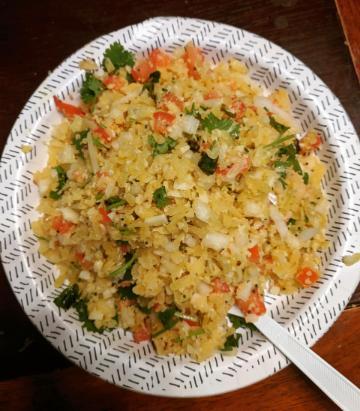
Dadpe pohe is a popular snack in the state of Maharashtra, India. The novelty about this recipe is that you need not cook the poha (flattened rice) and the veggies are raw as well. It is an evening snack but can serve as a breakfast or a light meal too. The recipe is easy to make, tasty (sweet and spicy), and requires almost no cooking efforts. Chop Chop Chop and done!
My Mom has her own kind of touch to the food she prepares and dadpe pohe was amongst the one that she received compliments for every single time she served it. After coming to the US and eating whatever is available amidst the hectic schedule each day, I got extremely bored of the same food all the time. That is when I remembered dadpe pohe. One fine day when I was all free I decided to spend my day cooking this recipe and satisfy my cravings. I called my Mom, asked her the recipe, only to realize that I already had almost all the ingredients required and I need not visit the supermarket. Hush! Also, I was not going to spend all of my day cooking (as I had imagined previously). Yay!! It is that quick.
I wonder why it took me so long to learn this recipe from Mom. But as they say, better late than never! Ever since dadpe pohe has been my go-to and comfort food, be it a busy day between exams or a day when you have nothing to do. I love the sweet, spicy, and a bit of tangy taste altogether and this is what dadpe pohe serves! There was no stopping me, learning this recipe from Mom.
Directions
From my Mom's kitchen!
For serving a group of 2
Preparation (Most of it) + Cooking time (Negligible) - 15-20 mins
Ingredients:
- Thin flattened rice (Thin poha) - 2 cups
- Fresh coconut - 2 tablespoons, finely grated (can use frozen grated coconut, fresh prefferd)
- Onions - 1, finely chopped
- Tomato - 1, finely chopped
- Lemon juice - 1 tablespoon (more if you like it!)
- Cilantro (Coriander leaves) - 1 tablespoon, finely chopped
- Green Chillies - 2 (according to your spice level)
- Curry leaves - 2-4 leaves
- Mustard seeds - 1 teaspoon
- Sugar - 1 teaspoon
- Salt - as per taste
- Turmeric powder - 1/2 teaspoon
- Cooking oil - 1 tablespoon
- Peanuts (Not really required, but you can add them as well!) - 8-10
Recipe:
- To begin chop onion, tomato, green chillies, cilantro and grated fresh coconut and get ready. Save a spoon of chopped onion, tomato, and grated fresh coconut each for the garnish later.
- Take a bowl, add 2 cups of flattened rice, chopped onion, tomato, grated coconut, lemon juice, sugar and salt and mix it well. Leave it aside for 10 minutes for the flattened rice to soak in the juices.
- For tadka (tempering) heat the cooking oil in a pan, add mustard seeds, add green chillies and curry leaves once the mustard seeds start crackling (if you are going to add peanuts add them before adding green chillies and curry leaves and roast them well). Now add turmeric powder and saute for a while.
- Add this tadka in the bowl of flattened rice and mix them well.
- Dadpe pohe is ready and you can serve them in a bowl or a plate. Garnish with the chopped onion, tomato, cilantro, and grated coconut that were kept aside.
Submitted by: Vidhati Khatod (Alumni)
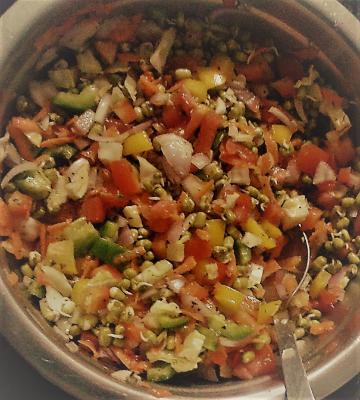
Greengram salad is refreshing and makes a nutritious meal by itself. We can play around with the veggies and make it interesting to suit our taste. Salad dressings of choice can be used. An all-time favourite because it's easy to make and a healthy option.
I developed a taste for sprouted green gram while I was at school. I tried to consume it in various forms. I used to make a smoothie as well. But felt that chewing the food satisfies my hunger better. Traditionally greengram daal (split green gram ) is used to make salads. I tried the same with sprouted greengram initially and then modified according to my taste. For more than 30 years I improvised and played around by adding veggies and fruits. Each time I make this, it will be different. The pomegranates add a sweet-tangy taste. Apples too go well in this salad.
Ingredients:
- 1 cup green gram -Soaked overnight and sprouted
- 1/2 cup sweet corn
- 3/4 th cup of fresh pomegranate seeds
- 1-2 finely chopped green chilies
- Handful of finely chopped coriander/ cilantro leaves
- salt to taste
- juice of a half lemon
- pinch of sugar
- 1/4 th cup fresh grated coconut -optional
- 1/2 cup grated carrots- optional
Method:
1. Mix all the ingredients in a deep pan and give it a mix.
2. Adjust salt, lemon, and chilies according to taste.
Note:
Since the green gram has to be soaked and sprouted plan it ahead by at least 2 days. Extra green gram can be sprouted and stored in the refrigerator for up to a week.
Submitted by: Smitha Jayaprakash (Student)
Har Lok is a shell-on shrimp dish with a tangy sauce. It's very flavorful and goes well with a simple bowl of steamed rice. Note: This recipe is an adaptation/spin on Sylvia Tan's Har Lok recipe. What's the difference? I use sherry vinegar (instead of wine), arrowroot flour (instead of corn flour), and brown sugar (instead of plain sugar).
I lived in Hong Kong for over a decade and Har Lok became one of my favorite dishes. This dish can also be found in Singapore and on the Mainland of P.R. China (Guangdong Province).
Ingredients:
1 pound of fresh shelled shrimp
1 teaspoon of salt
3 large minced garlic cloves
1 inch of grated ginger
5 thinly sliced stalks of green onion
Peanut oil (for sautéing)
Sauce:
1 teaspoon of arrowroot flour
2 tablespoons of soy sauce
1.5 teaspoons of brown sugar
1 tablespoon of ketchup
1 tablespoon of sherry vinegar
Preparation and Cooking instructions:
1. Wash, devein, and remove the whiskers of the shrimp. Use a paper towel to make sure the shrimp are dry. Place shrimp into a bowl and add the salt. Leave for 20 minutes fo the salt to marinate.
2. Mix the sauce ingredients in a separate bowl and place to the side.
3. Heat up 1/2 a cup of oil in your wok. Fry the shrimp in the oil once the oil is hot enough (you'll hear a sizzle). Only fry for 1-2 minutes and remove shrimp from the wok onto a paper lined bowl or plate so the oil can be absorbed.
4. Keep approximately 2 tablespoons of the oil in the wok and reheat the oil until very hot. Add the garlic and ginger into the wok and cook for 1 minute, then return the cooked shrimp to the wok, pour the sauce over the shrimp, and stir fry for 2-3 additional minutes. Add in the sliced green onions for another minute or so, and your dish is done.
Submitted By: Narine Kerelian (Faculty)
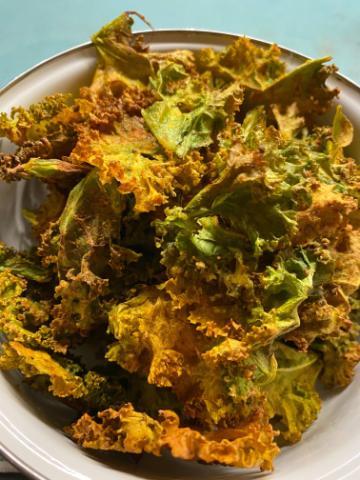
Pakoda is one of the most popular Indian snacks. It is basically veggies like battered in besan(chickpea flour) with spices and deep-fried. Some of the popular veggies used are onions, potatoes, spinach, plantains. I crave pakodas often, but I don't make them since they involve deep-frying which I have been avoiding. That's why I came up with this is a healthy take on pakoda. I took the good old American kale chips recipe but added besan(chickpea flour) and spice coating before baking them to crispiness. This proved to have the taste of crispy kale chips while giving the mouth-watering flavor of fried besan.
I love deep-fried stuff. But y'all know - a moment on lips, a lifetime on hips. So when I discovered the oven's ability to bake food to crispiness, I know what I wanted to make. I keep craving pakoras (battered veggies deep-fried). And I had been enjoying making and eating kale chips - (latter always takes the least time! :D)
So, I mixed my cravings for the Indian snack and my new favorite American snack - to make these Kale Chip Pakoras
Ingredients:
- Kale - a bunch
- Olive oil - 1 tbsp
- Chickpea flour, (available as besan in indian stores) - 2 tbsp
- Paprika or chilli powder - 2 tsp
- Ground pepper - 1 tsp
- Turmeric - 1 tsp
- Salt - 2 tsp
- Any other spice you like
Steps:
- Preheat the oven to 400F
- Strip all the kale leaves from its stem
- Wash the leaves, drain the water and place them in a bowl
- In a separate bowl, mix olive oil, salt, and the chickpea flour and mix well
- Add the spices mentioned above or any other spice of your choice and mix them too.
- Add this seasoning mixture to the kale and massage the kale till it is well coated. Kale leave need not be dried before this step. A little bit of moisture helps with the coating.
- Spread the kale on a baking tray. Make sure that all the leaves are well exposed.
- Place the tray in the oven for 20 minutes. Keep checking to make sure they don't get burnt as the timing might be different based on the oven.
- After they are done, take the tray out and let it cool.
- Enjoy crispy and crunchy besan coated chips.
Submitted by: Archana Kashikar (Alumni)
Mayak Gyeran (마약계란) also known as Korean marinated eggs is a popular side dish originating from South Korea. You can enjoy it anytime of day.
Directions:
Pair the soy sauce eggs with a steaming bowl of rice! Or eat them over soba noodles, ramen, etc. Eat them on their own – that’s how Koreans commonly enjoy them. These are very addictive and good. Chances are good, there won't be left overs!
Ingredients:
- 6 large eggs
- 1 tablespoon vinegar
- 1 tablespoon salt
- ½ cup soy sauce
- ½ cup water
- ⅓ cup honey or sugar
- 2 green onion (scallion), chopped
- 3 garlic cloves, minced
- 1 jalapeno pepper, diced (optional, or to taste)
- 1 tablespoon sesame seeds, toasted
Recipe:
1.) In a pot of water, add salt and vinegar. Then, bring it to a boil before adding 6 large eggs into the pot. To make your eggs soft-boiled, cook for 6 minutes. To make them hard-boiled, cook for up to 10 minutes.
2.) Run cold water on the drained eggs, or place in an ice bath for 10 minutes. After they have cooled, peel them carefully and store them in a container.
3.) Mix soy, water, and honey or sugar. Then, add garlic, green onions, pepper and sesame seeds. Stir the mixture well.
4.) Pour the marinade mixture all over the eggs. Refrigerate them overnight (or at least for 6 hours).
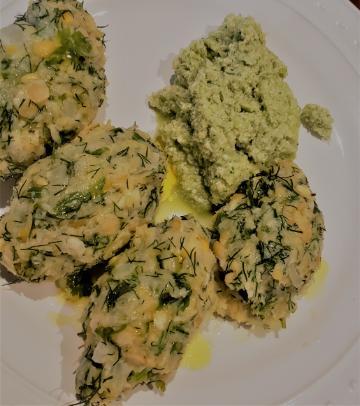
This is a traditional dish in South India. It is a healthy food since it is steamed and the dish is loaded with proteins. Onions, dill leaves and coriander gives it a distinct taste and add to the nutritional value. Ginger not only adds flavor but acts as a digestive. Dill and coriander add to the vitamin and mineral quotient. When served with coconut chutney and ghee it makes a scrumptious meal.
The base recipe can be used to make a couple of other dishes and snacks (Steamed Kadubu or masala vada). They can also be used as accomplishments along with the main course.
As a kid, I used to see my mom prepare this dish at least once a month. Back then, our choice of dishes for breakfast was very less. This dish was special and my mom made this during a holiday as this dish tastes best when it comes out of the steamer fresh. Enough of this can be made in one go if planned well and if we have the right vessels/ container. The best part was that the whole family would sit together to relish the dish. Since its high in proteins and ghee (clarified butter) is used as accompaniment, the whole experience is out of the world. And this dish is highly suitable for vegans and meets up with the protein requirements.
My mom would use the same base dough to make a variety of other dishes which was equally special.
One such dish was specially made during the "Ganesha" festival.
Required ingredients:
- Toor daal 1cup
- Channa daal 1 cup
- moong daal 1/2 cup
- 1 medium onion finely chopped
- 1 medium bunch of dill leaves finely chopped
- S handful of coriander/ cilantro finely chopped
- 8-10 curry leaves finely chopped
- 1 inch fresh ginger, grated
- 1-2 green chillies
- Salt to taste.
Method:
- Wash and soak the daals(pulses) for at least 4 hours (overnight preferred). throw in the chilies into the soaked daal mix
- Grind the soaked daal to a coarse paste (do not add water while grinding the daal since you will need to shape it into elongated balls)
- Place the ground daal in a deep pan.
- Add all the chopped ingredients and salt to the ground daal and mix thoroughly.
- Divide the dough into lemon sized balls. Shape them into elongated balls.
- Meanwhile, boil some water in an idle cooker/ deep pan/ steamer.
- Place the shaped balls in the greased idli stand/ shallow pans/ steamer, place it in the deep pan or idli cooker cover
- Steam for about 10-12 mind or till the mixture is cooked well. (max 15 mins)
- The steamed "Nucchina unde is ready to have with coconut chutney and ghee as accompaniment.
Note:
- Do not allow the mixture to sit for a long time after adding onions as onions tend to release water once it hits the salt. The dough becomes soggy and shaping them into balls becomes difficult.
- Replacing dill with Methi (Fenugreek) leaves gives it a distinct flavor. Methi leaves are also good for keeping the sugar under control (beneficial for Diabetics).
- The same dough mixture can be patted into flat patties and deep-fried. It makes a tasty evening snack (MASALA VADA) to go with coffee/tea or as an accompaniment with the main course (lunch or dinner)
Submitted by: Smitha Jayaprakash (Student)
Oyakodonburi is a rice dish topped with eggs and chicken or tofu covered in a sweet soy sauce broth.
My Obaachan (grandmother) would make the best Oyako Donburi every summer when visiting her in Japan. When going off to college and having to learn to cook on my own, I asked my Obaachan for her Okayko Donburi recipe so I could make her delicious dish on my own.
Directions:
Ingredients:
2 1/2 cups of steamed rice (already prepared)
6 ounces boneless chicken or tofu, cut into bite-size pieces
4 green onions, sliced diagonally
4 eggs
Broth:
1 cup dashi broth
5 tablespoons soy sauce
2 1/2 tablespoons sugar
2 1/2 tablespoons mirin
Serves 4 as a main dish.
Heat the broth ingredients in a saucepan until the sugar dissolves. In a frying pan over low heat, pour 1/4 cup of the heated broth. Add a quarter of the chicken or tofu and green onions into the frying pan. Cook the chicken or tofu pieces, turning them over until thoroughly cooked (about 3 minutes), then beat an egg and stir it into the frying pan. Cover the frying pan with the chicken/tofu egg mixture. In the meantime, portion out one serving of the steamed rice into a deep bowl. When the egg has set, after about 1 minute, slip the mixture over one serving of rice. Repeat the process for the remaining 3 servings.
Submitted by: Elisa Yanagihashi (Staff)
Easy to bake muffin that does not need complex tools or that you be a patissier! This sugar-free keto dish allows for guilt-free snacking anytime during the day.
Ingredients
- 2 ½ cups Almond Flour
- 1 ½ spoons Baking powder
- ¼ spoon Salt
- ½ spoon Vanilla essence
- 3 eggs
- ¼ cup Olive oil
- ¼ cup Milk
- 1 cup Blueberries
Directions
- Mix the dry ingredients first then fold and mix with the wet ingredients.
- Bake for 25 minutes in a muffin pan.
- Let it cool down before you eat it!
Submitted by: Rekha Kannan (Alumni)
My Swedish grandmother made it. This flat skillet bread can serve as a dinner roll at the evening meal, as a wrap for sandwiches and even as breakfast or dessert, when warmed and slathered with butter and jam.
Ingredients
-
4 cups peeled, cooked potatoes, cut into chunks (from about 3 pounds total)
-
8 tablespoons (1 stick) unsalted butter, melted (see headnote)
-
1/4 cup heavy cream
-
1/2 teaspoon salt
-
2 to 2 1/2 cups flour, plus more for dusting and rolling
Directions
Use a potato ricer to break down the cooked potatoes, then place them in a mixing bowl.
Add the butter, cream and salt; use your clean hands to knead the mixture (in the bowl) until it is well incorporated and lump-free; it will look and feel like firm mashed potatoes. Cover and refrigerate overnight.
The next day, combine the potato mixture with flour, adding 1/2 cup of the latter at a time, kneading (in the bowl) the crumbly mixture into a dough that is firm and not sticky at all. Use your hands to form 36 golf ball-size balls (for 7-inch lefse) or 18 larger balls (for 12-inches).
Dust a work surface and rolling pin with flour. Working with one at a time, flatten each ball of dough into a disk on the work surface, then roll it out to a round that is the desired size (mentioned above). Use a dry pastry brush to brush off any extra flour on the lefse round. You should see small bits of potato in the dough. Re-flour the rolling pin, as needed.
Heat a dry griddle or large skillet over medium to medium-low heat (at 4 out of a possible 10 on an induction burner). Once it's hot, add 1 round of dough at a time (or a few, depending on the size of your cooking surface); cook for 1 1/2 to 2 minutes on the first side, until the lefse bubbles on top and browns in spots underneath; turn over and cook for about 2 minutes on the second side, until more brown spots form underneath and the lefse is fragrant. Transfer to a clean dish towel and cover to keep warm. Repeat to use all the dough.
Submitted by: Susan Popko (Staff)

A semla is a Swedish cream bun pastry. It has a marzipan type filling, whipped cream and dusted with powdered sugar. Semlor is the plural form of semla.
Directions:
For the dough:
7 tablespoons unsalted butter
1 cup milk
2 teaspoons active dry yeast
2 eggs, divided
1/4 cup natural cane sugar
2 teaspoons cardamom seeds, crushed
1/2 teaspoon salt
3 to 3 1/2 cups white whole wheat flour (or substitute 3 1/2 cups all-purpose flour)
For the filling:
1 1/2 cups blanched almonds
3 tablespoons natural cane sugar
zest of 1 Meyer lemon
1/2 to 1 cups milk, depending on dryness of filling
1/2 to 1 cups heavy whipping cream, whipped
confectioners' sugar, for decoration
Step 1: In a saucepan, melt the butter; then stir in the milk. Heat until warm to the touch (about 110° F/43° C). In a small bowl, dissolve the yeast in 2 to 3 tablespoons of the warm mixture. Stir and let sit until bubbles form on top of the yeast, about 10 minutes.
Step 2: In a large bowl, whisk together 1 of the eggs, the sugar, cardamom, and salt. Pour in the remaining butter and milk mixture, along with the yeast, and stir until well blended. Mix in the flour, a 1/2 cup at a time, until you can work the dough together into a ball (you may not need all of the flour). Work the dough together well, by hand or with a wooden spoon.
Step 3: Transfer the dough to a flat surface and knead it until smooth and elastic, 3 to 5 minutes. The dough should feel a little wet, but if it sticks to your fingers and the countertop, add a little flour. Go lightly, though; if you add too much, the buns will end up dry. The dough is fully kneaded when you slice into it with a sharp knife and see small air bubbles throughout. Return the dough to the bowl, cover with a clean tea towel, and place in a draft-free place to rise for 45 minutes to an hour.
Step 4: Grease a baking sheet or line with a Silicone baking mat. Divide the dough into 12 equal parts and roll into balls. Place on the baking sheet with about 2 inches (5 centimeters) between each bun. Cover and let rise for 30 to 45 minutes.
Step 5: Preheat the oven to 400° F (200° F). Whisk the remaining egg and brush on top of the dough balls. Bake for 10 to 15 minutes, until the tops are golden brown. Remove from the oven, transfer the buns to the counter, and cover with a tea towel to let cool.
Step 6: To prepare the filling, mix the almonds, sugar, and lemon zest in a food processor until the almonds are finely ground and the mixture starts to stick together.
Step 7: Cut a circular “lid” off the top of each bun and set aside. Then cut a circle on the inside of each bun, leaving about 1/4 inch (1/2 centimeter) for a border and being careful not to cut all the way through to the bottom. Scoop out the cut portions with a spoon and place in a large bowl. Stir in the almond mixture until well blended. Then pour in enough of the milk to make a filling that’s thick and smooth yet not too liquidy. If you are making just a few semlor and don’t want to make the full filling, for each bun you will need about one heaping teaspoon of almond paste and 4 teaspoons milk.
Step 8: Fill the buns with the filling and top with the whipped cream. Place the lid on top of the whipped cream and dust with confectioners’ sugar. Serve immediately.
Submitted by: Christopher Hanson (Staff)
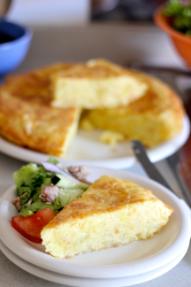
This dense, egg, and potato omelet dish is a very common Spanish tapa (appetizer). With only four ingredients, it is simple, delicious and can be served by itself, with veggies or meat on top, or placed in between baguette slices with a tomato spread to make a sandwich.
When I studied abroad in Spain back in 2002, vegetarian was not a word that was well understood. At restaurants, I would tell the waiter that I was vegetarian and I would end up with a tuna salad. Tortilla de patatas was one of the few dishes I could have when eating out as a vegetarian and I had a Spanish roommate who taught me how to make it.
Ingredients
- Lots of olive oil (I like extra virgin olive oil)
- Lots of salt (I like sea salt)
- Russet, or similar, potatoes (3-4 large for a large tortilla)
- Eggs (5-7, depends on the consistency of the mixture)
Directions
Dice or cut potatoes into pieces that are about 1” or less all around. You can peel the potatoes if you want. I like the skin so I generally leave it on.
Heat up olive oil so that potatoes will immediately start cooking, medium/medium high heat (oil bubbles). Use enough oil that it entirely covers the potatoes (yes, it’s a lot!).
Gently move potatoes around occasionally and keep an eye to make sure oil continues to entirely cover the potatoes. Cook until potatoes begin to soften. You can test this with a fork.
In a bowl, mix 5-7 eggs (I recommend starting with less as you can always add more if need be).
Empty the potatoes into a separate bowl. There will be a lot of oil that comes with the potatoes, but do not let all of the oil into the bowl, it should be mostly potatoes.
Remove oil from pan. Reduce heat to low/low medium.
Mash a bit with a fork. Add bowl of scrambled eggs. The consistency should be thick with a little liquidity from the eggs and oil, like a thick chunky cake batter. If it still just looks like potatoes, add another egg and mix it in. It’s ok that the eggs may start to cook during this mixing.
Pour mixture into pan. Spread out so that top has a fairly even surface. Let cook a few minutes.
Grab a large plate that is the same size or larger than the top of the pan. Put plate upside down on top of pan. Quickly flip and return tortilla to the pan to cook the other side for a few minutes. Once cooked through, remove from pan and enjoy.
Submitted by: Lisa Fabiny (Staff)
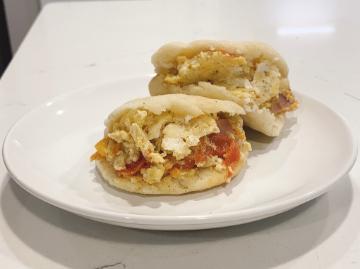
Arepas are made out of cornmeal, baked in the oven, and stuffed with any filling of your choice! My favorite fillings include scrambled eggs or shredded beef. This is my mother's recipe. I grew up eating this dish for breakfast, lunch, and/or dinner.
Ingredients for Mom’s Recipe
- Pre-cooked white cornmeal / Arepa mix
- 1 teaspoon salt
- Lukewarm water or milk
- 1 tablespoon vegetable oil / alternative
- 1 tomato
- ½ onion
- 6 eggs
- 2 slices ham
- Small bell pepper
Utensils Needed
- Medium-large bowl
- Frying pan
- Oven
- Spatula
- Plate
Instructions for Mom’s Recipe (for 4 arepas)
Filling
- Dice tomato, ½ onion, and ham. Finely slice the bell pepper.
- Sautee the tomatoes, then add onion, ham, and bell pepper. Sautee.
- Add in 4-6 eggs and fold into other ingredients until thoroughly cooked.
- Set aside until arepas are done.
Arepas
- Preheat the oven to 375 ºF.
- Pour warm water, or milk, into a bowl. Add the one teaspoon salt and the cornmeal gradually.
- Knead with your hands until a smooth dough is formed. Let the dough rest for 5 minutes.
- Separate the dough into 6-8 portions.
- Take one portion of the dough and shape into a ball, then press it with your palms to form a cornmeal patty.
- Place arepa onto an oiled frying pan on medium heat for 3 minutes for each side.
- Remove arepa from the frying pan and transfer to the oven. After 5 minutes, flip arepas and cook until outside puffs up.
- Take out the oven and stuff with the filling of your choosing!
Submitted by: Bri Platt (Student)
My host brother taught me to make this dish while I was studying abroad in Costa Rica. I'd never cooked plantains before. He fried them and I helped press them into disks. My favorite topping is the one my host brother used: a slice queso fresco on top.
Ingredients
- 2 green plantains (4-5 patacones per plantain)
- Oil for frying use an oil that won’t burn at high temperatures (peanut oil or avocado oil)
- Salt to taste
Directions
- Peel the plantains by slicing into the peel lengthwise. Cut on one of the angles and peel back.
- Cut the plantains into 1 inch thick slices.
- Heat the oil over medium-high heat in a frying pan. Use enough oil to almost cover the plantain slices.
- Fry the plantains until they start to get yellow, but not golden.
- Remove the plantains and place them on a cutting board or flat surface. While the plantains are still warm, use the bottom of a glass to smash and flatten them into 1/2" thick disks.
- Sprinkle the plantain slices with salt.
- Return the flattened plantains to the oil and fry until golden on each side, about 1-2 minutes per side.
- Remove from the oil, drain again on paper towels, and add additional salt if needed.
- Serve warm as a side dish or as an appetizer with dipping sauces or slices of queso fresco.
Submitted by: Mary Simms (Staff)
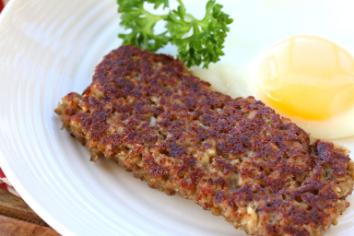
Goetta was brought to Cincinnati, Ohio over a century ago by German immigrants from northern Germany. While the version in north Germany would have been made more commonly with buckwheat, barley or rye (the grains most prolifically grown in that area), oats were substituted once the immigrants reached Cincinnati (which is the more common crop in that area). Also, the original, peasant German version would have included more animal organ parts whereas goetta is made with the muscle meat only (when the German immigrants reached the United States they found that pork here was much cheaper).
Ingredients
2 1/2 cups steel-cut oats (aka pinhead oats)
4 cups beef broth
4 cups water
3 teaspoons sea salt
3 bay leaves
1 1/2 teaspoons dried marjoram
1 pound ground beef
1 pound ground pork
1 large yellow onion, finely chopped
5 cloves garlic, minced
1 teaspoon ground ginger
1 teaspoon ground mace
1/2 teaspoon freshly ground black pepper
1/2 teaspoon freshly ground white pepper
1/2 teaspoon ground coriander
1/4 teaspoon ground cloves
US Customary - Metric
Directions
Place the broth, oats, water, salt, bay leaves and marjoram in a large pot. Bring it to a boil then reduce the heat to low, cover, and gently simmer for 90 minutes, stirring occasionally, until it's soft and the liquid is absorbed.
Add the meat, onions, garlic and spices. Return to a boil then reduce to low, cover and cook for another hour, stirring occasionally. If the liquid has not all been absorbed, remove the lid and continue to cook uncovered, stirring occasionally until the mixture has thickened.
Pour and press the mixture into 2 (9x5) greased loaf pans and let cool completely. Cover with plastic wrap and refrigerate overnight.
To serve, cut into thick slices, at least 1/2 inch (otherwise they'll fall apart; I cut them inside the pan, if you invert the whole thing it will be very messy), and fry them in batches in a non-stick pan over medium-high heat without any oil. Again, do not use oil, use a dry, non-stick pan.
Fry them on both sides for 4-5 minutes or until browned and crispy on the exterior.
Notes
THIS FREEZES WELL: Wrap the loaf pans and freeze for up to 2-3 months. Let fully thaw before slicing and frying. Alternatively, pre-slice it and place the slices between wax paper, then freeze. That way you can conveniently grab however many slices you need at a time without thawing the whole loaf.
Submitted by: Natasha Civ (Staff)
Cong You Bing (蔥油餅), also known as “scallion pancake” is a popular flatbread dish from northern China that many enjoy as a savory appetizer / snack. You may have seen it as a popular hit at dim sum restaurants!
My mom and I like to cook healthier versions of famous dishes, so this recipe uses less salt and oil. However, free to adjust to your preference!
- 2 cups organic all-purpose flour
- Scallions (a bunch)
- Vegetable oil (we like to use avocado oil)
- 1 cup water
- Salt (adjust to your liking)
- Add water to a bowl of flour, using chopsticks or fork to mix. Add a little oil so it won’t stick too much. Mix well and roll dough into a ball. Let it sit in the bowl, covering it with a wet paper towel. Leave it for 20 to 30 minutes.
- Chop the scallions into fine pieces.
- Take the dough out and roll it up a little. Then, cut it into 3 pieces.
- Take one piece of the dough and roll it flat to a very thin layer. Sprinkle salt to your taste, using a rolling pin to set the salt in. Then, brush oil over the layer, and spread out the chopped scallions.
- Start to roll the layer up, and secure the ends, so the green onions don’t fall out.
- Curl the dough to a ball again, flatten it slowly and gently to form a round pancake.
- Add oil to your pan, add the prepared pancake, and cook both sides until golden brown.
- Repeat steps 4-7 with the remaining pieces of the dough.
Submitted by: Lili Ghezavat (Student)
Lamb Skewers 羊肉串儿 (yang rou chuan) is a popular street food originating from Xinjiang province.
When I visited China, the streets were filled with food vendors selling lamb skewers. I would always buy a few every time I went for a walk with my grandparents. I haven’t been back to China recently so I started cooking them at home!
- 1 lb. boneless lamb leg
- ½ teaspoon salt
- ½ teaspoon cumin
- 1 tablespoon chili flakes
Recipe:
- Cut lamb into ½ inch cubes
- Add salt, cumin and chili flakes in a bowl with the meat.
- Marinate for 30 minutes.
- Add meat to skewers.
- Broil for 5-7 minutes.
- Flip skewers over and broil again for 5-7 minutes.
Stir-fried tomatoes and Scrambled Eggs (番茄炒蛋), is a popular dish in Chinese-speaking communities.
My grandmother would make this simple dish during family gatherings and was something my cousins and I would fight over. As a person who had just started getting into cooking this was a dish, I wanted to learn to make. Easy to make a dish for someone who likes eggs and tomatoes. It can be enjoyed on its own or with rice.
- 3 eggs
- 2-3 tomatoes
- Oil
- Ketchup
- Green onion
- Salt
- 2-3 teaspoon water
- Sugar (optional)
Recipe:
- Crack and whisk 3 eggs, add a pinch of salt
- Cut tomatoes into wedges
- Cut green onion
- Add a generous amount of oil to the pan on medium heat
- Add egg to the pan when the pan is hot
- Remove egg when 60-70% cooked
- Cook tomato on low heat add ketchup to enhance flavor
- Add green onion
- Add 2 tablespoons of water to stir-fry tomato, add sugar (optional)
- Add egg back in and finish cooking to your liking
Submitted by: Brandon Kuo (Student)
Korean BBQ Pork & Rice is a popular dish in South Korea and in other Asian countries, such as China.
My Step Grandma is Korean, but she’s vegetarian so she never makes this dish. I like this dish because it has a lot of the same flavors she uses, but it is filling and quick and easy to make.
- 1 Cup Cooked Short Grain White Rice
- 1 Tbsp Sesame Oil
- 0.5 lb sukiyaki pork or beef (ultra thin sliced)
- 1 green onion chopped
- 2 Tbsp Korean BBQ sauce
- Heat oil in a wok or cast iron skillet over medium high heat.
- Lay out meat in the pan in one layer (work in batches if needed)
- Keep stirring meat the entire time it is in the pan until golden brown (approx 30-45 secs)
- Take out meat and place on a paper towel
- Place rice in the bottom of a shallow bowl. On top, add meat, and top with green onion and Korean BBQ sauce to taste.
